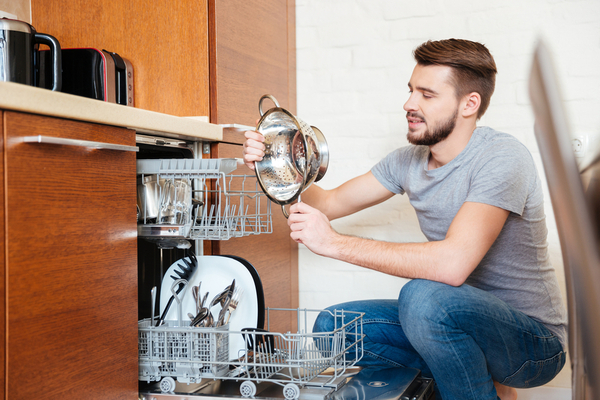With many of us still abiding by stay-at-home orders, those of us lucky enough to own a dishwasher are really putting them to work. While we might typically eat lunch at the office or enjoy a dinner out every now and then, we’re now cooking at home more often than ever—which also means more dishes to wash than ever before. When my refrigerator died a few days ago (after one of the biggest food shops of my life, naturally), it got me thinking about how valuable our kitchen appliances are right now, and how we can better take care of them. Luckily, the appliance pros at Maytag and Samsung were willing to share their best advice for how to maintain a dishwasher. Follow the pro-approved dos and don’ts listed below, so your dishwasher continues performing at its peak.
1) Clean the dishwasher filter.
Both the experts at Maytag and Samsung agree: cleaning the filter is a must (especially if you notice dishes aren’t coming out clean). To wash the filter by hand, just follow a few simple steps. All dishwashers are a little different (you can always check the manufacturer’s instructions), but these basic guidelines work for most models:
- Remove the lower rack to expose the bottom of the dishwasher—and you’ll spot the filter. Turn the filter counterclockwise to remove the filter door, then take out the filter.
- Run the filter and the filter door under clean water, using a toothbrush to dislodge any stuck food particles. Bonus: you can also give the filter a soak in white vinegar.
- Once the filter is clean, reinstall it. Turn the filter door clockwise to make sure it locks in place.
2) Use a descaler if you have hard water.
“Over time, minerals can build up in your water and cause issues for your dishwasher,” says Mark Horton, brand manager at Maytag. Horton recommends using Affresh dishwasher cleaning tablets ($6, lowes.com) once a month to clear out limescale and mineral buildup.
3) Make sure the water running to your appliance is hot.
Horton also recommends checking that the water going to your dishwasher is hot (120 degrees Fahrenheit). “If the water delivered to the dishwasher is cold, the unit will run longer to reach and maintain the optimal temperature,” he warns.
4) Load the dishwasher the right way.
Both appliance experts stressed the importance of loading the dishwasher correctly—every single time. Here’s Real Simple’s complete guide, but also a few basics to keep in mind, below.
- Arrange dishes so the dirtiest surfaces face in towards the center of the machine.
- Place pots and cups facing down, so water can spray into them.
- Remove food debris and any packaging scraps. “These things could damage the dishes, create
5) Run full loads.
“Waiting for fuller loads can reduce the number of cycles that run on your dishwasher, which optimizes water usage and likely leads to a longer overall lifespan,” says Horton.
6) Don’t forget to check the spray nozzle.
After loading the machine, spin the spray nozzle by hand to make sure it can move freely and doesn’t collide with any dishes or pot handles that are sticking out.
7) Do not put “do not wash” items in the dishwasher (seriously!).
There are some items you should never clean in the dishwasher because they could get destroyed, and then there are items you should never clean in the dishwasher because they will destroy the appliance. Here are a few items that fall into the latter category: candle jars, jars and cans with paper labels, fine china and delicate glassware.
8) Watch for standing water.
In some dishwashers, there will be a little bit of water left in the bottom of the appliance, but if you’re noticing an inch of water, it could be a warning sign of a clog. Before you call in the pros, try these tips to unclog the appliance yourself.
—
Photo Credit: Dean Drobot / Shutterstock.com
